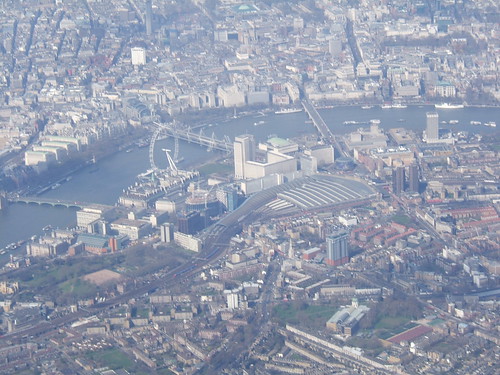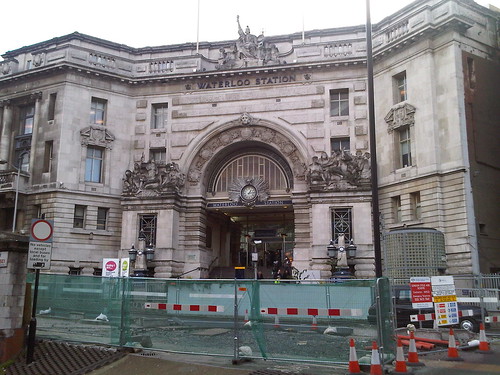I was brought up in the West Midlands in the early days of the post-war Nationalised railway so, although I was familiar with both the former L.M.S. and G.W.R. lines where I lived, the former Southern Railway was very much a 'foreign railway' to me. Around 1951 my mother and I visited Waterloo and other London termini during an extended trip (which even took us to Boulogne, described here). The 'Southern' electrics were very unfamiliar but there was plenty of steam to look at - particularly the 'air-smoothed' Bulleid 'Pacifics'.
 A Bulleid 'Pacific' leaving Waterloo (Photo: British Railways).
A Bulleid 'Pacific' leaving Waterloo (Photo: British Railways).
It was only many years later when I started to discover some of the history of the lines in the south of the country. Waterloo was the London terminus of the London and South Western Railway, which was well-regarded for its locomotives, less so for its passenger coaches and stations. In the 20th century, the London and South Western Railway rebuilt the nondescript Waterloo, producing a terminus which was much admired. The column-free concourse and the platforms were covered by an airy glazed roof and there was an impressive array of offices on the road side of the concourse.
 View across the Concourse at Waterloo in the 'Southern' era (Photo: British Railways).
View across the Concourse at Waterloo in the 'Southern' era (Photo: British Railways).
I'm afraid I don't think the station has been much improved in recent years. The modern ticket barriers and retail outlets now encroach onto the platform side of the concourse which is further narrowed by the new mezzanine floor on the road side. Overhead, a bewildering array of suspended signage, CCTV cameras and loudspeakers destroys the original sense of space without easing the traveller's route through the clutter very much. Of course, it's all aimed at increasing the 'retail opportunities' offered to 'customers'.
 View across the Concourse from the mezzanine adjacent to platform 1 in 2013.
View across the Concourse from the mezzanine adjacent to platform 1 in 2013.
Post-War developments
Upon Nationalisation of the railways in 1948, the Southern Region of British Railways absorbed the assets of the Southern Railway. The Southern Railway had been created by the 1921 Railways Act which grouped railways into the 'Big Four' (L.M.S., G.W.R., L.N.E.R. and S.R.). The Southern Railway brought together the London Brighton and South Coast Railway, the South Eastern and Chatham Railway and the London and South Western Railway. Steam working was eliminated and third-rail electrification (started by the Southern Railway in the 1930s) was extended to more destinations. Perhaps the biggest change in recent years was the building of Waterloo International to handle the 'Eurostar' trains on the Channel Tunnel route. However, once our very-first High Speed Railway was completed to St. Pancras International (briefly described here), Waterloo International was abandoned and currently wears a forlorn air as Network Rail decide just how much money will be needed to convert the area for use by other trains.

A modern view of Waterloo Station (centre) with Hungerford Bridge leading to Charing Cross station towards the top. Although the station and rail approaches have been extended since first built, the way in which the line from Nine Elms was extended over arches is still apparent. The long platforms of Waterloo International (beyond the earlier train shed) served the 'Eurostar' trains until High Speed One diverted these trains to St. Pancras International.
 Click for larger image
Click for larger image
Another aerial view of Waterloo.
Origins of Waterloo Station
The London and Southampton Railway was promoted as early as 1831 and a limited service started on 21st May 1838 between a London terminus at Nine Elms and Woking Common. As construction of the line towards Southampton continued, the name of the railway was changed to the more impressive-sounding 'London and South Western Railway'. A branch to Richmond was opened in 1846 but the growing traffic showed up the inadequacy of Nine Elms as a terminus. An extension was authorised from Nine Elms to a new station near the south end of Waterloo Bridge called 'Waterloo'. In 1848, Nine Elms was closed to the public (although retained for Royal Trains and goods) when all passenger traffic was diverted to Waterloo. The initial Waterloo Station had four platforms with two 'middle lines'. The L.S.W.R. intended to extend the line beyond Waterloo to get nearer to the City of London, which was the ultimate destination for many of its regular passengers. As a stop-gap, one of the 'middle lines' was extended to form a through connection with the South Eastern Railway (later to become the S.E.C.R.) but today there's only a pedestrian connection between the terminal platforms at Waterloo and the through platforms at Waterloo East. As an alternative, the L.S.W.R. supported the initiative to build an underground electric railway from Waterloo to the City. Initially, it operated the railway on behalf of the Waterloo and City company, but it later acquired ownership. There's a little more on the Waterloo & City Line in the article here or, for a detailed history of the Waterloo and City Line, see Book [3] below.
 A modern view of the imposing main entrance for foot passengers provided by the L.S.W.R. at Waterloo. After the 'Great War' of 1914-1918, this entrance became the Memorial to L.S.W.R. staff lost in World War I. The view is rather spoilt by the 'temporary' works in the foreground.
A modern view of the imposing main entrance for foot passengers provided by the L.S.W.R. at Waterloo. After the 'Great War' of 1914-1918, this entrance became the Memorial to L.S.W.R. staff lost in World War I. The view is rather spoilt by the 'temporary' works in the foreground.
Related posts on this web site
Visiting former 'Southern' stations in London (describes Waterloo East).
Waterloo Station, London (Part 2).
External web sites
London Waterloo Station (Wikipedia).
Waterloo (Network Rail).
My Pictures
Waterloo Station.
Books
[1] 'London's Termini' by Alan A. Jackson, published by David & Charles (0 330 02746 6). (The L.S.W.R. Terminus at Waterloo is described in Chapter 11).
[2] 'Railway Track Diagrams Book 5: Southern and TfL' Third Edition, published by TRACKmaps (ISBN 978-0-9549866-4-3).
[3] 'The Waterloo & City Railway by John C. Gillham, published by the Oakwood Press (ISBN 0 85361 544 6).
[9-May 2013: Second aerial photo added, reference to Book [3] added. 18-Sep-2015: 'Related posts' added.]
skip to main |
skip to sidebar

The occasional and probably unreliable recollections of an aging female.

About Me
- Jan Ford
- Jan passed away on 13 July 2024.
Jan's blog will be maintained, both in her memory and also as a source of reference material in many areas of interest. New posts will be added, to continue to record the ongoing influence of Jan's work and life.
Jan:
I've been an electronics engineer for over 57 years and I'm interested in travel, history, architecture, the industrial revolution, science, railways and, well, lots of things. I believe in what one of my heroes, Richard Feynman, called "The Pleasure of Finding Things Out".
'Labels to select a blog topic' (below) will select the posts on a particular subject.
The Search Box (with the magnifying glass symbol) in the header will find posts including any particular word or phrase.
'Links to photographs' (below) will take you directly to my photographs on 'Flickr'.
You can contact me at jan.c.ford@gmail.com.
Labels to select a blog topic
- Antarctic Peninsula (8)
- Australia-2017 (10)
- Battlefield Line (98)
- Brewood Hall (48)
- Burma-2012 (21)
- Burma-2014 (21)
- Burma-2015 (20)
- Burma-2016 (25)
- Burma-2017 (24)
- Burma-2017(2) (20)
- Burma-2018 (24)
- Burma-2019 (17)
- CA1 (1)
- Caledonian-Sky (23)
- Caspian Odyssey (11)
- CH1 (2)
- Charity Work (76)
- Chilean Fjords (22)
- China (17)
- DMU (23)
- Education (72)
- Engineering (24)
- FE1 (1)
- FE2 (22)
- FE3 (27)
- FE4 (25)
- FE5 (12)
- FE6 (25)
- Flying (8)
- Heritage (94)
- Index (10)
- Istanbul (4)
- j1 (16)
- Loco-profile (12)
- London Underground (6)
- Malta (8)
- ME1 (21)
- Medical Support (48)
- Merseyside (50)
- MIC (70)
- model railways (25)
- MOSI (28)
- Music (4)
- Myanma-Railways (75)
- Myanmar (2)
- Nepal (6)
- New York (7)
- None of the above (78)
- NW1 (13)
- OLCO (44)
- Peak Rail (68)
- Railway Signalling (203)
- Railways (719)
- RTW1 (3)
- RTW2 (1)
- RTW3 (1)
- RTW4 (31)
- RTW5 (29)
- Russian-railways (15)
- safari (28)
- Sam (3)
- Santa Specials (17)
- South Atlantic Voyage (19)
- Telecomms (8)
- Thomas (12)
- Tibet (9)
- Traffic Movements (42)
- Trans-Siberian (17)
- Travel (681)
- Trip to Burma (11)
- Trip to Russia (19)
- Trip to St. Helena (9)
- Tropic of Capricorn (17)
- Ty Gwyn (15)
- Tyseley (4)
- Work (36)
Blog Archive
- ► 2014 (102)
- ▼ 2013 (153)
- ► 2012 (151)